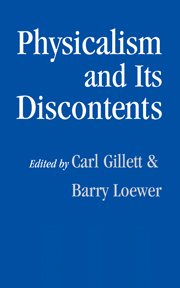Book contents
- Frontmatter
- Contents
- Contributors
- Preface
- Part I Physicalism
- 1 The Rise of Physicalism
- 2 From Physics to Physicalism
- 3 Sufficiency Claims and Physicalism: A Formulation
- 4 Realization and Mental Causation
- 5 Physicalism and Psychology: A Plea for a Substantive Philosophy of Mind
- 6 Davidson and Nonreductive Materialism: A Tale of Two Cultures
- 7 Substance Physicalism
- 8 Possibility: Physical and Metaphysical
- Part II Physicalist Discontents
- Part III Physicalism and Consciousness: A Continuing Dialectic
- References
- Index
7 - Substance Physicalism
Published online by Cambridge University Press: 02 November 2009
- Frontmatter
- Contents
- Contributors
- Preface
- Part I Physicalism
- 1 The Rise of Physicalism
- 2 From Physics to Physicalism
- 3 Sufficiency Claims and Physicalism: A Formulation
- 4 Realization and Mental Causation
- 5 Physicalism and Psychology: A Plea for a Substantive Philosophy of Mind
- 6 Davidson and Nonreductive Materialism: A Tale of Two Cultures
- 7 Substance Physicalism
- 8 Possibility: Physical and Metaphysical
- Part II Physicalist Discontents
- Part III Physicalism and Consciousness: A Continuing Dialectic
- References
- Index
Summary
How should we define physicalism or minimal physicalism? In my view, this question calls for stipulation because these are theoretical terms without a uniform use. Different views of psychophysical relations are physicalistic in different ways and to different degrees, and there is an obvious interest in clarifying and distinguishing these views and determining which are true. My aim in this chapter will be to do some of the clarifying and distinguishing. Stipulation of a unique thesis as physicalism or minimal physicalism must come with a rationale, and as I have none to offer I shall not pursue this.
Some regard physicalism as the thesis that all first-order properties instantiated in the spatiotemporal world are physical properties. I shall refer to this as type physicalism or property physicalism. It can be presented in the form of a supervenience thesis – another popular way of defining physicalism – on the assumption that a property is physical if and only if it logically supervenes on microphysical properties. This is one way, or a first approximation of a way, of characterizing a physical property in terms of microphysical properties. But as I think that the following discussion will apply on any reasonable view of physical property, I will mostly continue to talk of physical properties without getting more specific. I shall assume that it will be clear enough to think of a microphysical property as an assignment of fundamental microphysical parameters in some type of spatial or spatiotemporal region, where the fundamental microphysical parameters are those featuring in an ultimate microphysical theory.
- Type
- Chapter
- Information
- Physicalism and its Discontents , pp. 152 - 171Publisher: Cambridge University PressPrint publication year: 2001
- 3
- Cited by



